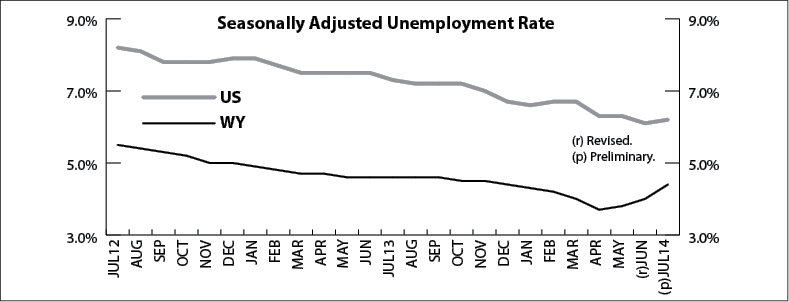
Wyoming Unemployment Rate Rises to 4.4% in July 2014
The Research & Planning section of the Wyoming Department of Workforce Services reported that the state’s seasonally adjusted1 unemployment rate rose from 4.0% in June to 4.4% in July 2014 (this is a statistically significant increase). It is normal to see some fluctuations in unemployment rates. After trending down for more than four years, the recent rise in unemployment is not corroborated by other labor market measures, such as claims for unemployment insurance benefits. Unemployment in Wyoming was slightly lower than its July 2013 level of 4.6% and significantly lower than the current U.S. unemployment rate of 6.2%. Seasonally adjusted employment of Wyoming residents decreased, falling by an estimated 1,978 individuals (-0.7%) from June to July.
Most county unemployment rates were quite stable from June to July, rising or falling by 0.1% or less. Unemployment rates fell in Teton (down from 3.3% to 3.0%), Sublette (down from 3.3% to 3.1%), and Carbon (down from 4.4% to 4.2%) counties. The largest unemployment rate increases were found in Platte (up from 4.9% to 5.3%), Fremont (up from 5.5% to 5.8%), and Big Horn (up from 5.0% to 5.2%) counties.
From July 2013 to July 2014, unemployment rates increased slightly in 15 counties, fell in six counties, and were unchanged in two counties. The largest decreases were seen in Goshen (down from 5.1% to 4.7%), Teton (down from 3.2% to 3.0%), Fremont (down from 6.0% to 5.8%), and Campbell (down from 3.7% to 3.5%) counties.
Teton County posted the lowest unemployment rate in July (3.0%). It was followed by Sublette (3.1%), Converse (3.4%), and Campbell (3.5%) counties. The highest unemployment rates were found in Fremont (5.8%), Platte (5.3%), and Big Horn (5.2%) counties.
Total nonfarm employment (measured by place of work) rose from 297,900 in July 2013 to 302,600 in July 2014, a gain of 4,700 jobs (1.6%).
1Seasonal adjustment is a statistical procedure to remove the impact of normal regularly recurring events (such as weather, major holidays, and the opening and closing of schools) from economic time series to better understand changes in economic conditions from month to month.
